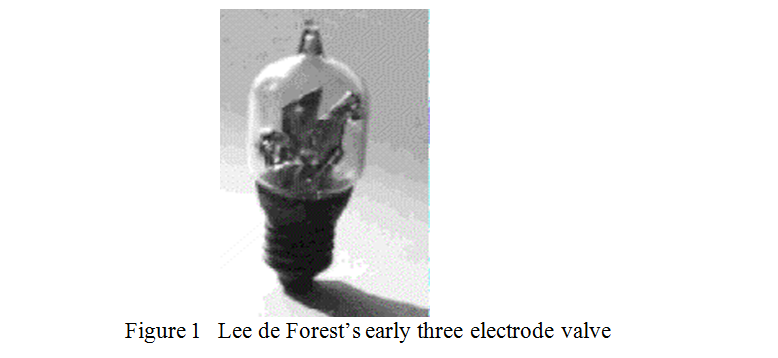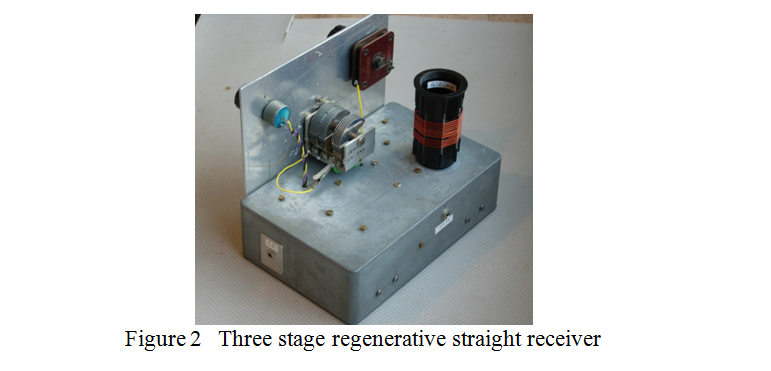The Triode, the start of modern electronics
| Back |
|---|
When, in 1906, the American engineer Lee De Forest first had what is now called a “grid” put into a sample of Fleming’s diode, he didn’t really know what to expect and didn’t take advantage of it for some time. A museum photograph of one of De Forest’s early devices is shown in figure 1

For one thing, although in theory the new three electrode valve was capable of amplification, the gain was extremely modest and there were already other ways of amplifying telegraph signals, including ultra sensitive electro-mechanical relays and a speech amplifier for use with the telephone system comprising an earpiece and a carbon microphone sharing the same diaphragm. But the new tube, or “Audion” as de Forest called it, was starting to have some success as a “detector” of wireless waves.
Early valve detectors were what are now known as “Anode bend” detectors, which relied on the non-linearity of anode current with grid voltage. It seems that they hadn’t yet cottoned on to the much more sensitive “grid leak” detector, but it did at least achieve detection at least comparable with Fleming’s diode. Improved versions were gradually developed over the next few years, and some small amplification at radio as well as audio frequencies was achieved.
The real breakthrough came in 1912, when the American electrical engineer Edwin Howard Armstrong invented the regenerative circuit.
Although in hindsight, this was a logical development following on from amplification, its importance cannot be overstated. In essence regeneration comprised feeding back a small proportion of the amplified received wireless waves into the input in a carefully controlled manner, either just short of, (or in a special case just beyond), the point of self oscillation. By this means, the gain of the device could be increased at least a million fold. Moreover, not only was the gain greatly increased but the selectivity was similarly increased just at a time when this was urgently needed due to the enormous increase in telegraph traffic, mainly of maritime origin. By using the same feedback principle to make a power valve oscillate, pure unmodulated carrier waves could be produced, occupying a single frequency rather than the huge bandwidths of spark, quenched spark or even arc transmitters. By increasing the feedback to make a detector valve oscillate, these new “pure frequency” CW telegraph signals could be heterodyned to an audio frequency and could then be read with unprecedented clarity. Within another five years, in 1917, the “Superhet” was born forming the basis of virtually all modern radio receivers
Although, for several years prior to this , there had been tentative experiments with the transmission of voice using arcs and high frequency alternators with direct modulation of the RF by a carbon microphone, their application was extremely limited before the arrival of the triode Nevertheless, by 1915 wireless telephony had become firmly established using valves, at least in principle. The “Poulson arc”, invented in 1917, did however provide a temporary challenge to high power “CW” transmissions using valves. The Poulson arc consisted of an arc between metal electrodes in a hydrocarbon vapour together with a strong transverse magnetic field, and could develop several kilowatts of RF power at frequencies up to at most 100 kHz.
In my teen-age years, I experimented with “straight” regenerative, (or reaction), receivers like many other boys and I still have my radio log from those years, showing amateur stations from all over the world. Amplitude Modulation, or AM was the only mode used in those days and it was well suited to reception by straight regenerative receivers. The secret of success was to achieve really smooth reaction, such that as you slowly increased the reaction control via its slow motion drive, you could hear a slight hiss or breathing sound and you could hold it there before the circuit actually oscillated. Some valves worked better than others. The best results were achieved with an HF stage preceding the regenerative detector, followed by a single stage of audio amplification feeding a loudspeaker. I used this receiver for short wave listening right up to the early 1950s, when I converted it to a superhet. I eventually decided that the superhet was no more sensitive than the straight receiver but was much easier to use and of course more selective. In fact straight receivers require considerable skill to achieve their maximum sensitivity, usually requiring the use of both hands simultaneously on the tuning and reaction controls.
Recently, I have tried to re-create a similar straight regenerative receiver using transistors instead of valves and it was by no means easy to achieve the same smoothness of reaction. In summary, the semi-conductor junctions in the transistors seemed to change their characteristics between the oscillating and non oscillating states such that reaction was either “ploppy”, i.e. showed a measure of hysterysis, or gave what used to be called “threshold howl”. I eventually achieved success using MOSFETs. The resulting three stage receiver, capable of driving a loudspeaker, was capable or receiving almost anything that my much more modern communications receiver can receive, (selectivity permitting), although to prove this one had to find the weak station first with the communications receiver and then prove that the straight receiver could also hear it. The latter is shown in figure 2 below.

Back to history! The straight regenerative receiver had its hay day between the mid 1920s and the early 30s. In the earlier part of this period, it was severely rivalled by the humble crystal set on account of the latter’s cheapness, and in the later part by the superhet on account of its great ease of tuning for ordinary members of the public. Up to about 1940, in both amateur and professional use, the only modulation formats in common use were amplitude modulation for voice (AM), and interrupted continuous wave, (CW), or tone amplitude modulated CW (MCW)for Morse. Frequency Modulation was invented by Edwin H. Armstrong in 1936 but not much used until the 1950s. However, pulse modulation was used in various ways during World War ll both for radar and multi channel communication. Apart from Morse, I have not attempted to cover the various other digital modes, such as the International Telegraph Alphabet as used in RTTY, or other alphabets used in Amtor, SITOR, ASCII, X 25 etc.
Just to round off this brief history, the first amateur radio contact across the Atlantic was made in 1921. Then of course there came television, single sideband and complicated data protocols, but all this is too recent to be classed as history. Perhaps in another fifty years someone else will write up these and other recent developments in suitable highly condensed form!
| Back |
|---|
THE END
John G0NVZ